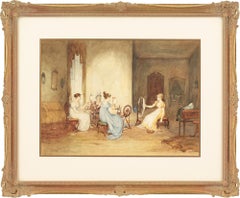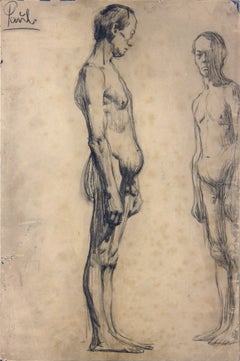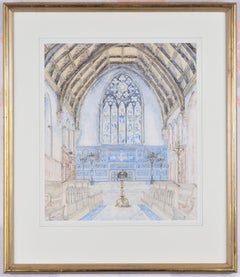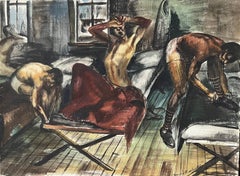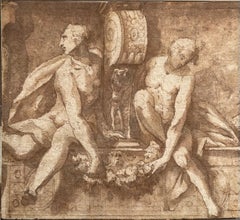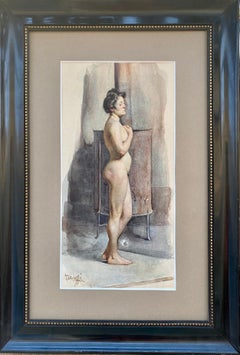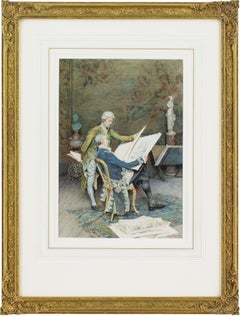1890s Interior Drawings and Watercolors
to
4
4
1
1
1
Overall Width
to
Overall Height
to
15
71
461
293
7
10
18
47
26
62
22
25
31
32
13
1
4
3
6
4
3
3
1
1
1
1
1
1
1
1
4
4
1
1
1
6
6
1
Period: 1890s
Paris modernist scene mixed media drawimg
Located in Barcelona, Barcelona
Joan Cardona Lladós (1877-1957) - Modernist Paris scene - Mixed media (charcoal and white wax).
Drawing measurements 40x29 cm.
Frame measurements 66x54 cm.
He was born in Barcelona on June 30, 1877, he was registered with the name of Juan Bautista José Pedro. His parents Josep Cardona i Farré (Sant Salvador, 1852-Barcelona, ?) and Maria Lladós i Vidal (Isona, 1855-Barcelona, 1935) came from Sant Salvador de Toló and Isona, respectively, two towns very close to Tremp, in the Pallars Jussà region, close to the Lleida Pyrenees. The Cardona Lladós family was of humble origins, linked to the rural and peasant world. José Cardona and María Lladós married around 1876, when they were twenty-five and twenty-one years old respectively. The couple decided to improve their precarious situation by moving to live in Barcelona.
In 1877 Joan Cardona was born in the family home, at 62 Mediana de San Pedro Street, in the Ribera neighborhood of Barcelona and very close to the Rec Comtal. Joan Cardona was the firstborn of three brothers. When he was six years old, his sister Consuelo was born (1883) and later his younger sister, María (1888), was born. Josep Cardona i Farré was a day laborer and lived at least until the birth of his third daughter, María, in 1888. Her death, for reasons unknown to us, would occur shortly after.
After the death of Josep Cardona, León Farré i Duró (Isona, 1867-Barcelona, 1932) became part of the family nucleus with his mother María Lladós, who took care of the child Cardona and his sisters Consuelo and María.
Farré learned to play the guitar and was the most extraordinary disciple of the composer and guitarist Francesc Tàrrega i Eixea (Vila-real, 1852-Barcelona, 1909). Joan Cardona had in her stepfather the man who instilled in her a special musical and artistic sensitivity. The young Cardona took classes at the Academia Baixas, inaugurated in 1892 by the painter Joan Baixas i Carreter and installed on Carrer del Pi, a private center where a good batch of leading Catalan Modernisme artists were trained.
Cardona married Clemencia Parade Cazabat at the beginning of the century. Daughter of Carles Parade and Amara Cazabat, she was born in 1870 in Bagnères de Bigorre...
Category
Modern 1890s Interior Drawings and Watercolors
Materials
Mixed Media
$7,573 Sale Price
35% Off
George H Hay, Spinning Wool, Watercolour
Located in Cheltenham, GB
This late 19th-century watercolour by Scottish artist George H Hay RSA (1831-1912) depicts four young ladies, wearing outfits synonymous with the 1820s, spinning wool within a simple...
Category
Romantic 1890s Interior Drawings and Watercolors
Materials
Watercolor, Paper
Fine Antique 19th Century Italian Watercolor Roman Interior Scene Painting 1880
Located in Portland, OR
A very beautiful watercolor painting by the celebrated Italian artist Daniele Bucciarelli (1839–1911), of a interior scene circa 1880.
The painting depicts the interior of a grand ro...
Category
Italian School 1890s Interior Drawings and Watercolors
Materials
Watercolor
Self-portrait - Homo nudus -
Located in Berlin, DE
Bruno Paul (1874 Seifhennersdorf - 1968 Berlin). Self-portrait, c. 1895. Pencil on paper, mounted on cardboard, 53.5 x 35 cm, signed 'Paul' at upper left.
- Homo nudus -
About the artwork
In a mirrored situation, Bruno Paul looks at himself in the picture. While his body, which is the size of the format, is shown in profile parallel to the picture, he turns his head into the picture in order to become aware of himself there, whereby the lighter use...
Category
Realist 1890s Interior Drawings and Watercolors
Materials
Pencil
$3,262 Sale Price
20% Off
Louis Tinayre (1861-1942) An encampment of journalists, signed drawing
Located in Paris, FR
Louis Tinayre (1861-1942)
An encampment of journalists in Chambéry,
signed and titled lower left "Campement de journalistes à Chambéry"
Ink on paper
In quite good condition, a a visible vertical fold in the centre, some stains and foxings
21 x 29 cm
Framed : 33.7 x 45.5 cm
Louis Tinayre's background and adventurous life obviously inform this humorous and detailed scene. He demonstrates a remarkable sense of observation, capturing this scene of extraordinary life like a journalistic illustrator.
A contributor, to whom I'd like to express my sincere thanks, sheds important light on the nature of this scene.
It appears that this drawing is the draft for an illustration published in “Le Monde illustré” of August 4, 1888 (page 77), to accompany the article “Épilogue du voyage présidentiel” (Epilogue to the presidential trip) - president Sadi Carnot- en Savoie et en Dauphiné (p. 74), which ends with: “As a picturesque note, we enclose an improvised journalists' dormitory in Chambéry, where our colleagues deeply regretted the comfort of the special train”.
As a quasi-ethnographic observer, Tinayre's interest lies in the journalists' camp, which he turns into a tender, comical scene. We understand him better when we know that he may have been similarly fascinated by the territories of Madagascar, the North Pole or the Far West that he painted and drew.
Louis Tinayre was born on 14 March 1861 in Neuilly-sur-Seine. His mother, Victoire Tinayre, was a teacher and a member of the International Workers' Association.
Louis was the son of a Communard couple. His father, Jean Joseph, known as Jules Tinayre (Issoire 1821 - Paris 1871) was shot during the Bloody Week. His mother, Victoire Tinayre, fled with her children. Louis was the first to be sent to Hungary, and the rest of the family (including his brother Julien) joined him there later. He studied Fine Arts at the Hungarian University of Fine Arts in Budapest.
Returning to Paris in 1880 (after the amnesty), Louis Tinayre assiduously frequented Le Chat noir, where he met the positivists and Adèle Jacomet (Buenos Aires 1867-1946), whom he married in 1888.
He became an animal painter and press illustrator and was sent by Le Monde Illustré to cover the second expedition to Madagascar (then under French protectorate) in 1895.
He stayed there, fascinated, for six months and produced numerous drawings and photographs. Back in France, he created eight 5 x 4 meters dioramas presented at the National and Colonial Exhibition in Rouen in 1896.
He returned to Madagascar in 1898 to prepare the creation of a giant panorama representing the surrender of Antananarivo in 1895. The Malagasy pavilion at the 1900 Universal Exhibition in Paris allowed him to admire the dioramas (on the ground floor) and the panorama (on the first floor).
On his second trip, Tinayre took a Lumière cinematograph with him to document the daily life of the Malagasy people, no doubt to facilitate the design of the vast panorama. These short films were donated to the Cinémathèque française in 2009 by his grandson, Alain Tinayre.
One of the admirers of Tinayre's drawings, watercolours, paintings and photographs at the Universal Exhibition was Prince Albert I of Monaco: from 1901 onwards, Tinayre accompanied him on his hunts, painting scenes in North Africa, Russia, the Far West (Wyoming) and the North Pole. Tinayre, the official painter of the Prince's scientific expeditions, left his name to a glacier.
Together with the painter Alexandre Jean-Baptiste Brun, he painted the four murals in the large amphitheatre of the Oceanographic Institute in Paris. Louis Tinayre painted the figures while Alexandre Brun...
Category
Realist 1890s Interior Drawings and Watercolors
Materials
Ink
Charterhouse School Chapel watercolour by Meadows-Frost
Located in London, GB
To see our other public school pictures, scroll down to "More from this Seller" and below it click on "See all from this Seller."
Meadows-Frost (possibly Sir John Meadows Frost [185...
Category
1890s Interior Drawings and Watercolors
Materials
Watercolor
Man sitting in the studio - Thinking about art -
Located in Berlin, DE
Adolph Eduard Otto von Faber du Faur (1828 Ludwigsburg - 1901 Munich). Man sitting in the studio. Watercolour painting, 43 x 27 cm (visible size), 73 x 53 cm (frame), monogrammed at lower right, estate stamp.
Upper right corner neatly repaired, small tear in the wall to the left of the sitter.
- Thinking about art -
About the artwork
The sitter, an elderly man, is seated in a studio on a pedestal reminiscent of an academy hall. The earthy, dark tones give the scene a weighty quality. The lightest tones are found in the incarnate parts of the figure, which do not stand out from the other colours of the picture, but are linked to them. As a result, the sitter's face is both part of and the highlight of the colour references in the picture. The colour of the sitter's skin is reflected in his pink coat, while his white-grey hair matches the colour of the wall next to him. This almost monochrome wall surface, in turn, is connected across the portrait to the framed picture standing on the floor, which seems to have been erased by this correspondence with the empty wall surface. Through the palette, which is positioned directly behind the sitter's head, the reference to painting, which is already given by the studio space, is explicitly linked to the sitter, who thus seems to be contemplating the question of the meaning of art.
This raises the question of whether Faber Du Faur, who had become lonely in his old age, might have painted a self-portrait here in his later years. In addition to the studio setting, the sitter's explicit reference to the palette and the fact that the picture was part of his estate, the only summary elaboration of the body suggests a self-portrait, while the representation of the face is concretised with the wide-open eyes typical of a self-portrait. This concentration on the face gives the impression of the artist's melancholy introspection, captured by the palette and related to the meaning of painting, whose dark character is reinforced by the concealment of the palette hanging on the right of the picture in the light tones so characteristic of Faber Du Faur. In the course of this resignation, Faber du Faur advises his son Hans, who has also become a painter: "Promise me one thing: never move to Munich, they'll kill you here!"
Whoever the sitter may be, the references to painting make the portrait a resigned self-contemplation by Faber Du Faur, focused on art.
About the artist
After leaving school, Otto Faber du Faur entered the service of the Württemberg army, at the same time cultivating his artistic talent. In 1851, on the recommendation of his father Christian Wilhelm, who was himself a battle painter, he spent six months in Munich as an apprentice to Alexander von Kotzebue. In 1852 he was granted a year's leave of absence from military service to study battle painting in the studio of Adolphe Yvon...
Category
Realist 1890s Interior Drawings and Watercolors
Materials
Watercolor
$885 Sale Price
20% Off
Related Items
"Men in Barracks" WPA Mid 20th Century American Scene Realism Gay Modernism WWII
Located in New York, NY
"Men in Barracks" WPA Mid 20th Century American Scene Realism Gay Modernism WWII. 18 x 24 inches Watercolor on paper. c. 1940s. Signed lower right.
BIO
...
Category
American Realist 1890s Interior Drawings and Watercolors
Materials
Paper, Watercolor
Study for a fresco
Located in Paris, Île-de-France
Attributed to Francesco PENNI (1488 – 1528)
Study for a fresco
Pen and brown ink, brown wash heightened with white on prepared paper
14 x 12 cm
Unsigned
On the mount, handwriting ...
Category
Old Masters 1890s Interior Drawings and Watercolors
Materials
Ink
Ancient Egypt - Watercolor by R. Fedi - Early 20th Century
Located in Roma, IT
Ancient Egypt is an drawing in watercolor on cardboard realized by R. Fedi in 1922.
The state of preservation of the artwork is very good.
Hand-signed on the lower right and dated....
Category
1890s Interior Drawings and Watercolors
Materials
Watercolor
$1,456
H 28.55 in W 20.87 in D 0.04 in
Interior of the Nieuwe Kerk, Amsterdam
Located in Paris, Île-de-France
Jan Goeree (Middelburg 1670 – Amsterdam 1731)
Interior of the Nieuwe Kerk, Amsterdam (c. 1724)
Red chalk for the architecture, pen and black ink, grey wash on paper
Composition reversed in preparation for engraving
25 × 17.5 cm
Watermark: Hunting horn, Churchill 318 (dated 1724)
Unsigned
Provenance
Private collection, France
Context & Attribution
Trained in the studio of Gérard de Lairesse, Jan Goeree was among the finest Dutch engravers of the early eighteenth century, celebrated for his architectural views of Amsterdam. This drawing is a preparatory study for an engraving of the same subject now preserved in a major public collection. The final print—slightly larger—closely follows the reversed composition of this sheet.
Subject
In the center of the Gothic nave, five bearers carry a catafalque toward a freshly dug grave—a tribute to the naval heroes often buried in the Nieuwe Kerk. This funerary motif, familiar from Dutch painting (e.g. Emanuel de Witte, 1657), evokes the vanitas theme and the transience of earthly life.
Technical Analysis
Goeree’s use of red chalk for the architecture and ink for the figures reveals his working method: the chalk lines could be used to produce a counterproof restoring the correct orientation of the architecture, while the inked figures remained adjustable before the design was transferred to the copper plate.
Place within the Oeuvre
Drawings of church...
Category
Old Masters 1890s Interior Drawings and Watercolors
Materials
Ink, Chalk
People - Drawing by F.-A. Houbron - Late 19th Century
Located in Roma, IT
People is an ink on paper, realized in the late 19th Century by Frédéric-Anatole Houbron.
Monogram of the artist on the lower-left corner. Passpartout included cm 25.5x38
The artwork represents a sketch of a group of people in an indoor set.
Frédéric-Anatole Houbron was (1851- 1908).
Painter (gouache), watercolorist, draughtsman, he realized history painting...
Category
Modern 1890s Interior Drawings and Watercolors
Materials
Ink
$372
H 4.73 in W 7.68 in D 0.08 in
France 19th century, The Bohème artist in his workshop, watercolor
Located in Paris, FR
France circa 1850
The Bohème artist in his workshop
Watercolor on paper
15.5 x 21.5 cm
In good condition except a small tear (visible on the photographs) on the upper right border.
I...
Category
Romantic 1890s Interior Drawings and Watercolors
Materials
Watercolor
$671 Sale Price
20% Off
H 6.11 in W 8.47 in
Cy Twombly with pink chairs. From the Interiors series
Located in Miami Beach, FL
A new series inspired by architecture, décor and stylish personalities of the world of interior design.
The worlds of fashion, society and pop culture are captured in the illustrati...
Category
Contemporary 1890s Interior Drawings and Watercolors
Materials
Paper, Gouache, Acrylic
$2,500
H 36 in W 24 in D 0.1 in
'Cafe', Woman Artist, École Nationale Supérieure des Arts Décoratifs, Berkeley
Located in Santa Cruz, CA
Signed lower right, 'Marie Pascal' (French-American, 20th century) and painted circa 1990.
Exhibited: Gallery Concord, December 1991.
Marie Pascal studied at the École Nationale Sup...
Category
Realist 1890s Interior Drawings and Watercolors
Materials
Watercolor, Gouache, Illustration Board
$1,137 Sale Price
35% Off
H 13.25 in W 16 in
Original Erte Art Deco table watercolour and ink designs, 20th Century
Located in Petworth, West Sussex
Romain de Tirtoff called ERTE (Russian/French, 1892-1990)
Les emotions: La Tristesse et l’Indifference
Ink and watercolour
Inscribed with details and signed with studio stamp (lower...
Category
Art Deco 1890s Interior Drawings and Watercolors
Materials
Paper, Ink, Watercolor
$2,163
H 9.63 in W 14.13 in D 1 in
Ritual - Watercolor by E. Sacchetti - Early 20th Century
Located in Roma, IT
Ritual is an original drawing in watercolor on cardboard realized by the Italian artist Enrico Sacchetti as scenography for a theatrical representatio...
Category
1890s Interior Drawings and Watercolors
Materials
Watercolor
$1,747
H 28.35 in W 21.26 in D 0.04 in
Erte original furniture art deco designs in ink, gold paint and watercolour
Located in Petworth, West Sussex
Romain de Tirtoff, called ERTE (Russian/French, 1892-1990)
Meuble a Courrier
Ink, gold paint and watercolour
Inscribed with details (upper left) and signed with studio stamp (lower right)
11.1/2 x 15.1/8 in. (29.3 x 38.5 cm.)
Provenance: The personal collection of the artist
Gifted to Serge Leeman and thence by descent
Romain de Tirtoff, commonly known as Erté, is widely recognized as the most influential artist of the Art Deco movement. His distinguished career spanned over 80 years and crossed over into several mediums including fashion illustration, stage and costume design and bronze sculpture.
Erté was born on November 23, 1892 in St. Petersburg, Russia. His father was a military man...
Category
Art Deco 1890s Interior Drawings and Watercolors
Materials
Ink, Watercolor
$2,028
H 11.5 in W 15.13 in D 1 in
"Masha's fairy tales" watercolor cm. 17 x 22 1970
Located in Torino, IT
Children, illustrations, tales
Marina Evgenevna USPENSKAYA (Moscow, 1925 – 2007)
Marina Evgenevna Uspenskaya was born in Moscow. She graduated from the 1905 Art College, where she ...
Category
Realist 1890s Interior Drawings and Watercolors
Materials
Paper, Watercolor
$2,330
H 14.97 in W 13 in
Previously Available Items
Italian Art nouveau Nude Boudoir painting woman warming herself by a stove Paris
By Tito Lessi
Located in Norwich, GB
A very pure and tender rendition of a female nude. Elegant in its simplicity, the artist's model, is warming herself by a large stove!
It is a work by Tito Lessi dating from circa 1890. Lessi was born in Florence, Italy and studied at the Florentine Academy of Fine Arts, under Enrico Pollastrini and Antonio Ciseri...
Category
Academic 1890s Interior Drawings and Watercolors
Materials
Laid Paper, Watercolor
H 18.9 in W 12.6 in D 0.4 in
Giuseppe Signorini, The Connoisseurs
Located in Cheltenham, GB
This exquisite late-19th-century watercolour by Italian artist Giuseppe Signorini (1857-1932) depicts two art connoisseurs musing over an old master...
Category
Italian School 1890s Interior Drawings and Watercolors
Materials
Paper, Watercolor, Gouache
Interior Scene Sketch - Original Charcoal Drawing by J. Dreyfus-Stern
Located in Roma, IT
Interior Scene Sketch is an original artwork realized in pencil by Jean Dreyfus Stern in the first decades of the XX Century.
Pencil on paper.
Hand signed by the artist in ink on...
Category
1890s Interior Drawings and Watercolors
Materials
Charcoal
H 13.59 in W 10.24 in D 0.04 in
"Breaking Surf"
Located in Southampton, NY
Original watercolor by the American artist, George Howell Gay. Signed lower left. Circa 1895. Some condition issues. Repaired tear by signature. Two small scratches top left sky. Sm...
Category
Academic 1890s Interior Drawings and Watercolors
Materials
Paper, Watercolor
French Watercolor - Cathedral Interior
Located in Houston, TX
Uniquely hued watercolor of the interior of a classical, 1894. Signed lower right.
Original artwork on paper displayed on a white mat with a gold border. Archival plastic sleeve ...
Category
1890s Interior Drawings and Watercolors
Materials
Paper, Watercolor
Recently Viewed
View AllMore Ways To Browse
Bam Bam Vintage
Banksy Vinyl Record
Bark Cloth Paintings
Beagle Portrait
Bearbrick Mickey Mouse
Belvedere Hotel
Benjamin Herring
Birth Of Venus Botticelli
Bronze Kangaroo
Bunny Kate
Burgundy Wine Poster
Cafe De Flore
Canadian National Railway
Carlo Of Hollywood Abstract
Casa Cabana
Charles P Gruppe Paintings
Cheryl Summers
Chester Moon
